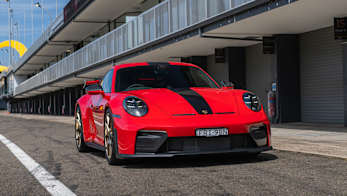What happens when you smooth out the design of an electric car to almost-unprecedented levels? You end up with a car like this, the new Hyundai Ioniq 6, which the brand boldly calls an “Electrified Streamliner”.
We’ll go with the traditional “sedan” title, thanks, but there’s some method to the madness of that name - because this slippery, swoopy-roofed model has a drag coefficient as little as 0.21 Cd, making it one of the most aero-efficient cars to ever make it to mass production.
That low number helps the Ioniq 6 become one of the most efficient electric cars to date, according to the Korean brand, but it’s not just a matter of eco-friendly design - the powertrain tech on offer is on point, too.
Powering the 2023 Hyundai Ioniq 6 sedan will be a choice of one or two electric motors - meaning the former will be rear-wheel drive, and the latter all-wheel drive.
As is the case with the Ioniq 5 crossover SUV EV, the Ioniq 6 will therefore have different power outputs depending on the grade.
The flagship model, with a 77.4kWh battery pack and dual electric motors, will produce a staggering 239kW of power and 605Nm of torque. That’ll be enough for it to silently speed from 0-100km/h in just 5.1 seconds.
The power outputs for the single-motor RWD version with the 77.4kWh battery pack are not yet confirmed, but it has a few other headline figures - namely the estimated WLTP driving range of 610 kilometres on a charge.
At launch in Australia those are the two versions we’re likely to see, though there is a version in some markets with a rear-motor and a 53kWh battery pack, which - due to its lighter kerb weight - has an early indicated efficiency of less than 14.0kWh per 100 kilometres, which is exceptional.
.jpg)
And, yes, there’ll be an even quicker one at some point, with Hyundai strongly suggesting an Ioniq 6 N model is on its way. Details on that car are scant, but you can expect that 0-100km/h time to drop considerably.
Charging for all Ioniq 6 models is a good story - the car is built on the E-GMP platform, with its fast 800-volt architecture allowing recharging in rapid time. Using a 350kW charger, Hyundai states the Ioniq 6 can recharge from 10-80 per cent in just 18 minutes.
Furthermore, Hyundai has the vehicle-to-load (V2L) feature, which allows you to run appliances (or even a house, in the event of a blackout) from the car’s battery.
Stay tuned for our first drive review of the new Hyundai Ioniq 6 EV in August: we tested the AWD model on private and public roads in Korea, in a camouflage prototype model.













.jpg)

.jpg)
.jpg)
.jpg)

.jpg)

.jpg)

.jpg)
.jpg)
.jpg)


.jpg)

